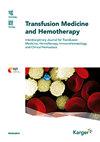evorpacept诱导的干扰及其在输血前检测中的应用
IF 1.9
4区 医学
Q3 HEMATOLOGY
引用次数: 0
摘要
& lt; b> & lt; i>简介:& lt; / i> & lt; / b>Evorpacept是一种cd47阻断剂,目前正在开发用于治疗各种癌症。据报道,在有限的血浆浓度下,evorpacept对输血前相容性试验的干扰。虽然提出了各种缓解战略,但没有一种是实际可行的。这项体外研究评估了evorpacept在大浓度下诱导的干扰,并研究了一种新型缓解剂Evo-NR的能力。& lt; b> & lt; i>方法:& lt; / i> & lt; / b>在evorpacept浓度高达2000 μg/mL时,使用手动凝胶卡和自动分析仪对加入evorpacept的血浆进行抗体筛选试验(抗e和抗jk <sup>a</sup>)或不含同种异体抗体。用直接抗球蛋白试验(DAT)检测evorpacept包被红细胞(rr [ce/ce], Fy[a+b−],S−S +),并用anti-Fy<sup>间接抗球蛋白试验(IAT)阶段的抗s试剂。Evo-NR用于消除血浆和红细胞样品中的干扰。采用流式细胞术评价缓解效果。& lt; b> & lt; i>结果:& lt; / i> & lt; / b>evorpacept加标血浆在使用手工凝胶卡(2+至3+)和自动分析仪(4+)进行抗体筛选试验时显示出泛反应性干扰。在自动分析仪中也观察到结转效应。使用3- 6倍摩尔过量的Evo-NR有效地解决了血浆中的干扰,并实现了准确的同种异体抗体鉴定。虽然通过流式细胞术鉴定了evorpacept与红细胞结合的减少,但Evo-NR无法解决IAT期DAT和抗原分型中观察到的血清学干扰。& lt; b> & lt; i>讨论:& lt; / i> & lt; / b>Evorpacept在高浓度下表现出持续的全反应性和携带效应。Evo-NR成功地解决了等离子体样品中的干扰,可以被认为是一种实用而有效的缓解方案。Evo-NR的实施有可能支持接受evorpacept治疗的患者输血。本文章由计算机程序翻译,如有差异,请以英文原文为准。
Evorpacept-Induced Interference and Application of a Novel Mitigation Agent, Evo-NR, in Pretransfusion Testing
Introduction: Evorpacept is a CD47-blocking agent currently being developed for the treatment of various cancers. Interference by evorpacept in pretransfusion compatibility testing has been reported at limited plasma concentrations. Although various mitigation strategies have been proposed, none are practical. This in vitro study assessed evorpacept-induced interference at extended concentrations and investigated the capability of a novel mitigation agent, Evo-NR. Methods: Antibody screening tests were performed on evorpacept-spiked plasma with (anti-E and anti-Jka) or without alloantibodies at evorpacept concentrations up to 2,000 μg/mL using manual gel cards and automated analyzers. Evorpacept-coated red blood cells (RBCs) (rr [ce/ce], Fy[a+b−], S−s+) were tested by direct antiglobulin testing (DAT) and antigen typing using anti-Fyb and anti-S reagents at indirect antiglobulin testing (IAT) phase. Evo-NR was used to resolve the interference in plasma and RBC samples. Flow cytometry was used to assess the mitigation effects. Results: Evorpacept-spiked plasma showed panreactive interference in antibody screening tests using manual gel cards (2+ to 3+) and automated analyzers (4+). A carryover effect was also observed in the automated analyzers. The use of a 3- to 6-fold molar excess of Evo-NR effectively resolved the interference in the plasma and enabled accurate alloantibody identification. Although the reduction in evorpacept binding to RBCs was identified via flow cytometry, Evo-NR was incapable of resolving the serologic interference observed in DAT and antigen typing at IAT phase. Discussion: Evorpacept showed constant panreactivity and a carryover effect at high concentrations. Evo-NR successfully resolved the interference in the plasma samples and could be considered a practical and efficient mitigation solution. Implementation of Evo-NR has the potential to support RBC transfusion for patients undergoing evorpacept treatment.
求助全文
通过发布文献求助,成功后即可免费获取论文全文。
去求助
来源期刊
CiteScore
4.00
自引率
9.10%
发文量
47
审稿时长
6-12 weeks
期刊介绍:
This journal is devoted to all areas of transfusion medicine. These include the quality and security of blood products, therapy with blood components and plasma derivatives, transfusion-related questions in transplantation, stem cell manipulation, therapeutic and diagnostic problems of homeostasis, immuno-hematological investigations, and legal aspects of the production of blood products as well as hemotherapy. Both comprehensive reviews and primary publications that detail the newest work in transfusion medicine and hemotherapy promote the international exchange of knowledge within these disciplines. Consistent with this goal, continuing clinical education is also specifically addressed.

 求助内容:
求助内容: 应助结果提醒方式:
应助结果提醒方式:


